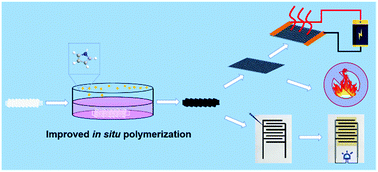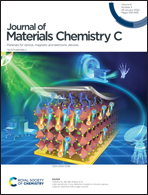Transforming commercial regenerated cellulose yarns into multifunctional wearable electronic textiles†
Abstract
Textile-based electronics hold great promise as they can endow wearable devices with soft and comfortable characteristics. In this work, a multifunctional conductive yarn was fabricated by coating a commercial regenerated cellulose (lyocell) yarn with polypyrrole (PPy). The method is simple, low-cost, and highly scalable and it endows the common lyocell yarn with flame-retardant as well as good electrical heating properties and excellent electrochemical performance. The PPy-coated lyocell yarn (PCLY) behaved as a regular yarn and could be hand-knitted into a full fabric. The PCLY fabric demonstrated high conductivity, allowing its use as a wearable Joule heater. The polypyrrole coating significantly improved the limiting oxygen index (LOI) of the lyocell yarn from 21.7% to 40.2%, endowing the yarn with an excellent flame-retardant property. PCLY was stitched into a fabric to form interdigitated electrodes and further assembled into flexible textile micro-supercapacitors. The resulting device with 10 interdigitated electrodes exhibited high areal specific capacitance of 663 mF cm−2 and energy density of 21.6 μW h cm−2 at 1 mA cm−2. Furthermore, six devices in series could power a blue light-emitting-diode (LED) of 3 V for more than 30 seconds. This facile fabrication provides novel and practical insights toward wearable textile-based electronics.



 Please wait while we load your content...
Please wait while we load your content...